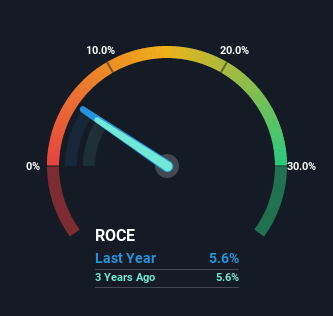[ad_1]
If you’re not sure where to start when looking for the next multi-bagger, there are a few key trends you should keep an eye out for. Ideally, a business will show two trends; firstly a growing return on capital employed (ROCE) and secondly, an increasing amount of capital employed. Put simply, these types of businesses are compounding machines, meaning they are continually reinvesting their earnings at ever-higher rates of return. However, after investigating Victoria (LON:VCP), we don’t think it’s current trends fit the mold of a multi-bagger.
Return On Capital Employed (ROCE): What Is It?
For those that aren’t sure what ROCE is, it measures the amount of pre-tax profits a company can generate from the capital employed in its business. Analysts use this formula to calculate it for Victoria:
Return on Capital Employed = Earnings Before Interest and Tax (EBIT) ÷ (Total Assets – Current Liabilities)
0.056 = UK£73m ÷ (UK£1.7b – UK£380m) (Based on the trailing twelve months to April 2022).
Thus, Victoria has an ROCE of 5.6%. Ultimately, that’s a low return and it under-performs the Consumer Durables industry average of 15%.
See our latest analysis for Victoria

In the above chart we have measured Victoria’s prior ROCE against its prior performance, but the future is arguably more important. If you’d like, you can check out the forecasts from the analysts covering Victoria here for free.
What The Trend Of ROCE Can Tell Us
Unfortunately, the trend isn’t great with ROCE falling from 12% five years ago, while capital employed has grown 432%. However, some of the increase in capital employed could be attributed to the recent capital raising that’s been completed prior to their latest reporting period, so keep that in mind when looking at the ROCE decrease. It’s unlikely that all of the funds raised have been put to work yet, so as a consequence Victoria might not have received a full period of earnings contribution from it.
The Key Takeaway
While returns have fallen for Victoria in recent times, we’re encouraged to see that sales are growing and that the business is reinvesting in its operations. These growth trends haven’t led to growth returns though, since the stock has fallen 49% over the last five years. So we think it’d be worthwhile to look further into this stock given the trends look encouraging.
One more thing, we’ve spotted 2 warning signs facing Victoria that you might find interesting.
For those who like to invest in solid companies, check out this free list of companies with solid balance sheets and high returns on equity.
Valuation is complex, but we’re helping make it simple.
Find out whether Victoria is potentially over or undervalued by checking out our comprehensive analysis, which includes fair value estimates, risks and warnings, dividends, insider transactions and financial health.
View the Free Analysis
Have feedback on this article? Concerned about the content? Get in touch with us directly. Alternatively, email editorial-team (at) simplywallst.com.
This article by Simply Wall St is general in nature. We provide commentary based on historical data and analyst forecasts only using an unbiased methodology and our articles are not intended to be financial advice. It does not constitute a recommendation to buy or sell any stock, and does not take account of your objectives, or your financial situation. We aim to bring you long-term focused analysis driven by fundamental data. Note that our analysis may not factor in the latest price-sensitive company announcements or qualitative material. Simply Wall St has no position in any stocks mentioned.
[ad_2]
Source link








